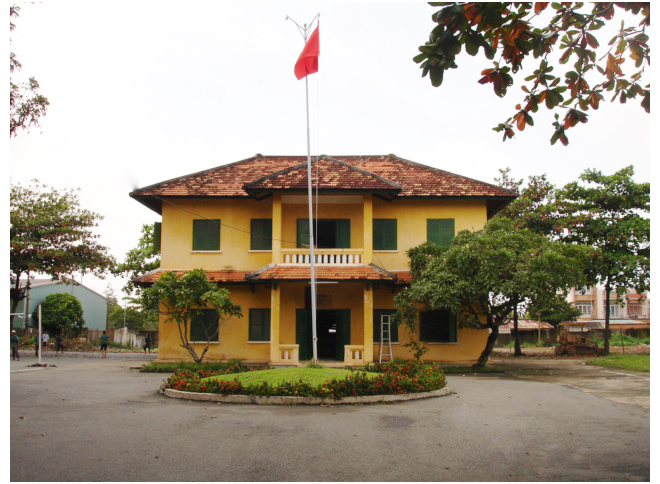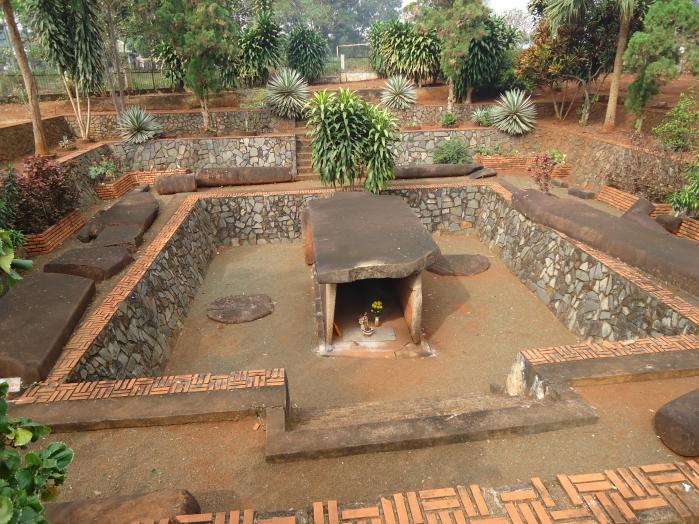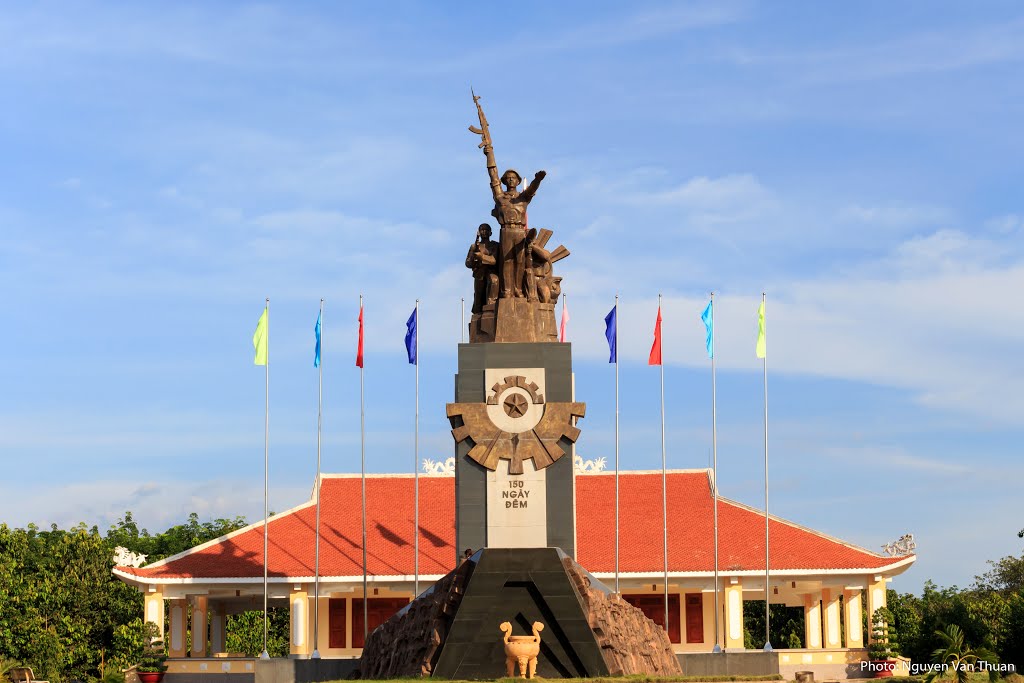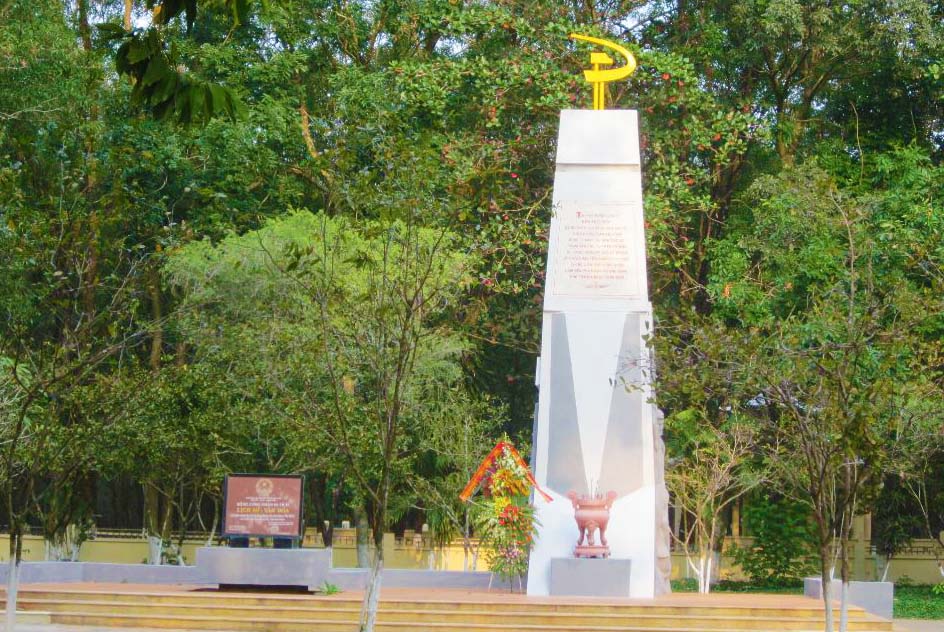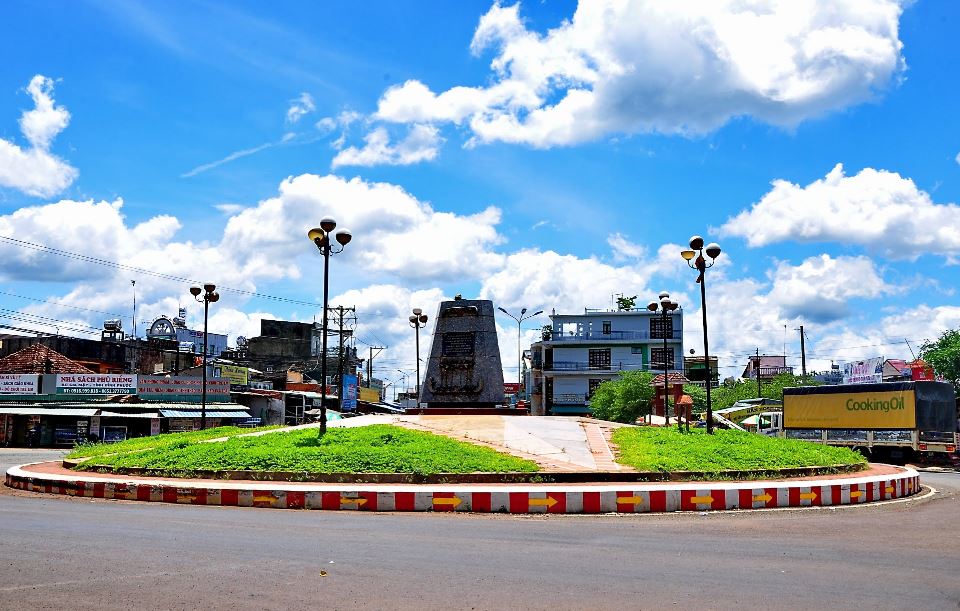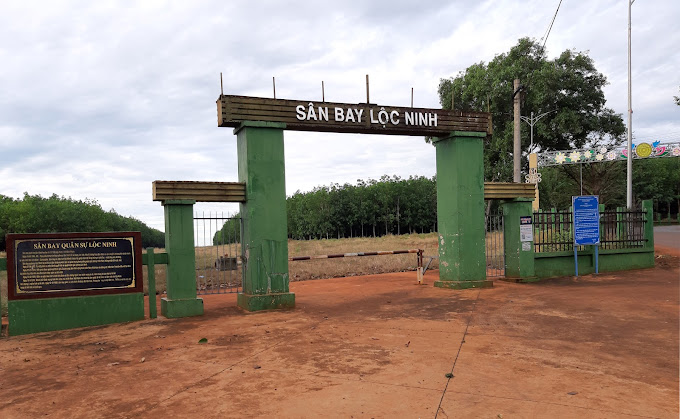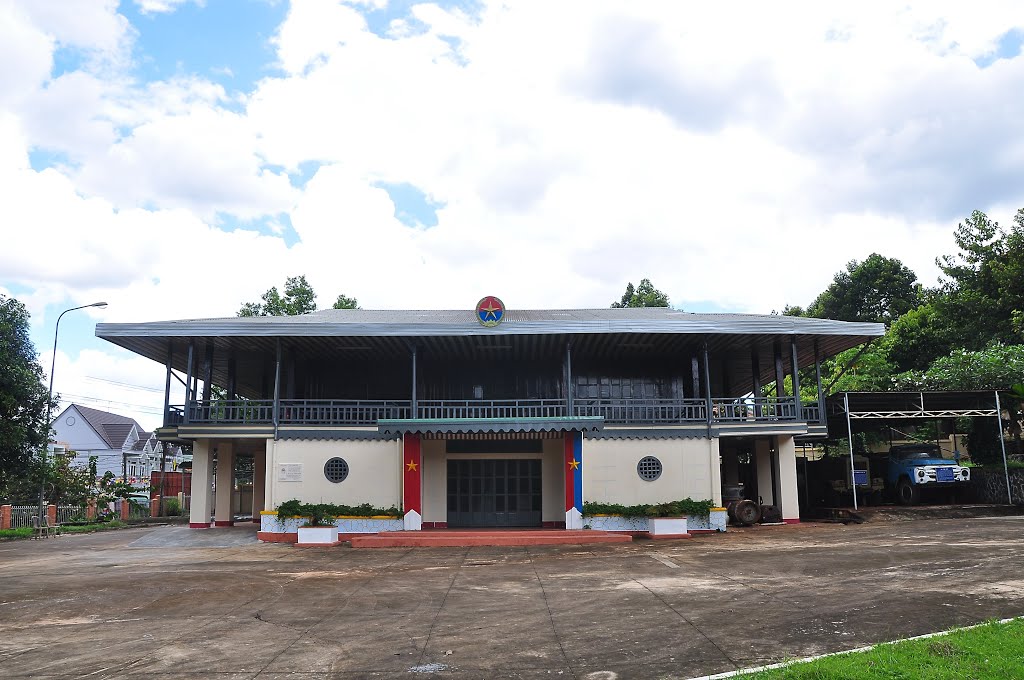Relic point Vietnam
Việt NamDong Nai Memorial Monument
The memorial - also known as the Soldier's Monument is located in the center of major roads in the inner city of Trung Dung ward, Bien Hoa city. This work was built by the French colonial government in 1923 with the name "Vietnamese Memorial Monument". This is an architectural work modeled after the Hue Ngo Mon style during the Nguyen Dynasty, constructed by Professor Robert Balick and his wife and a team of teachers and students of Bien Hoa Arts School. Under the skillful hands and aesthetic minds of artisans, the Soldiers' Monument was a unique work of that time and completely national in color. The stone pillars are carved with delicate lines, the ceramic patterns are elaborately done with harmonious colors. The stone stele engraved with Chinese characters records the names of people in Bien Hoa who died for France - they were colonial people who were conscripted and fought on fronts far from home that the French colonialists masterminded. In his work "The verdict of the French colonial regime", Nguyen Ai Quoc mentioned this relic when the French colonial government held its inauguration on January 21, 1923. This is a demagoguery of the colonial government. With a simple but extremely eloquent pen, Nguyen Ai Quoc dedicated his passionate words to stand on the side of the suffering people, condemning the brutal colonial regime that trampled on a nation, crushing every person of the land. slave country, sent a message, an indictment to oppressed countries, peoples and destinies that had only one way left: to rise up and liberate themselves. The appearance of the Soldiers' Monument relic was repaired and embellished with a spacious and beautiful campus, becoming a cultural park beautifying Bien Hoa City. Although more than three-quarters of a century has passed since its construction until now, time has faded and damaged many times, the Soldiers' Monument remains forever an irrefutable proof of the crimes of the real people. French people, reminding the people of Bien Hoa of a painful history under foreign domination so that they can rise up and build a prosperous and happy life. The Memorial Monument (Soldiers' Monument) was ranked a national historical relic by the Ministry of Culture and Information on November 16, 1988. Source: Dong Nai Electronic Newspaper
Dong Nai 5135 view
Dong Nai Green House historical site
The Blue House relic is located on the campus of Dong Nai Technical Workers School, Thong Nhat ward, Bien Hoa city, Dong Nai province. The relic was ranked as a national historical relic by the Ministry of Culture and Sports on December 12, 1986. The Green House was built in 1912 according to French architecture with modern materials, including a ground floor and a first floor. When first built, the Green House was used as the Office of Bien Hoa Industry and Forestry Company, abbreviated as B - I - F, "Bien Hoa Industrelle et Forestiere". In 1958, the Saigon government took this villa as a residence for the US Military Advisory Mission in Bien Hoa. This place is considered a safe and ideal location, surrounded by many posts and protected by security units. After Law 10 - 59 of the Republic of Vietnam regime, the war between us and the enemy became more and more difficult and fierce. The US increased its deep intervention in the South to plot to quickly destroy the revolutionary forces. Faced with that situation, the Eastern Provincial Party Committee decided to organize a raid on the American advisory delegation in Bien Hoa at the Blue House. On July 7, 1959, a special forces squad consisting of 6 comrades, Hue, Phu, Be, Sac, and Hung, led by comrade Nguyen Van Hoa, suddenly attacked the Blue House. In less than 15 minutes, our troops destroyed two American advisors Bui-s and Ovmand. This was a daring opening battle that shook the US - Diem government. The Blue House raid demonstrated the determination of the army and people of Bien Hoa to fight the US as a signal to encourage the revolutionary movement in Bien Hoa and the whole South, which was burning with enthusiasm. With the great historical significance of the first American battle at Bien Hoa. The Blue House exists as a historical witness affirming the determination of our army and people to fight and win against America. From 1986 until now, the Blue House has become a familiar address for people of all walks of life, pupils and students in Dong Nai and the whole country. Many international delegations have visited and expressed their admiration for the spirit. The bravery and daring intelligence of the revolutionary soldiers created a resounding battle, a pre-emptive battle that humiliated the will of the American army. The Blue House relic has been repaired many times in 1991, 1993, 1999. To meet the increasing sightseeing and learning needs of people and tourists, with the approval of the Department of Culture and Sports, In early December 2006, the Management Board of Monuments and Landscapes coordinated with the Dong Nai Technical Workers School to repair and upgrade the monument and is expected to complete it and serve visitors during the Lunar New Year. Dan. Source: Dong Nai Electronic Newspaper
Dong Nai 5482 view
La Nga victory relic
La Nga Victory Relic (at km 104-112 on Highway 20 to Da Lat, in Phu Ngoc commune, Dinh Quan district) was ranked a national historical relic by the Ministry of Culture on December 12, 1986. To cheer for the Viet Bac victory in the fall-winter of 1947 and also to deal a fatal blow to the enemy, the command board of squad 10 decided to organize a big battle, to show the enemy that the Vietnamese people were , Vietnamese people do not easily submit to any enemy; With a spirit of courage and ingenuity after nearly half a year of preparation, studying the terrain, and choosing a location: at 15:12 on March 1, 1948, the La Nga ambush battle began and ended at 15:12 on March 1, 1948. 15:57 on the same day, in just 45 minutes. The victory of La Nga delighted the people of Dinh Quan in particular and the people of Dong Nai in general. This is a victory that demonstrates the cunning and courage of our army and people, causing the enemy to be stunned and defeated. From this victory, our force grew stronger and stronger, contributing to defeating the enemy's plan to attack quickly and win quickly, forcing them into a passive position. The scenic complex of Chong Rock, Mai Waterfall, La Nga River and La Nga Victory Monument is an interesting tourist complex of Dinh Quan. The amazing beauty of Hon Ba Chong, Da Voi Mountain, Hon Dia, along with the natural pagoda at the foot of the rocky mountain are typical clusters that create a harmonious beauty for the Da Chong scenic area. Dinh Quan Da Chong Complex is also a place that retains traces of prehistoric life. Here, under the stone roofs, along the streams and on the slopes along the valley, many production and daily life tools of the ancients made of stone, bronze and terracotta were discovered. During the 30-year resistance war. Dinh Quan is an important part of War Zone D. Da Chong witnessed the formation, development, stationing, and combat deployment of revolutionary forces. Today, a part of the land of Da Chong Dinh Quan scenic area has been used and built into the Dinh Quan District Cultural and Sports Center. In the near future, Da Chong Dinh Quan scenic area will be invested in and renovated, contributing to making the natural landscape more beautiful and becoming an attractive eco-tourism destination. Source: Dinh Quan District People's Committee
Dong Nai 9846 view
Hang Gon Dong Nai Megalithic Tomb Relic.
Hang Gon Megalithic Tomb (also known as Hang Gon 7 Site, Indochina Tomb, Ong Da Tomb), located in Hang Gon commune, Long Khanh town, Dong Nai province, includes: Tomb area (discovered in 1927) and crafted (discovered in 1995). In 2011, the monument was renovated and embellished with a total area of 37,120 square meters, with the following items: Tomb area, processing area, Ong Da temple, Tho Than temple, auxiliary works (gates, fences). , internal road yard, duty - ticket sales house, shelter house, reception - display house, administration house). 1. Catacombs: The current Hang Gon Megalithic tomb relic, compared to its discovery in 1927, still retains the structure and current state of the tomb. However, the tomb-like relic is buried deep underground, about 3 meters above the current ground level. 2. Processing area: The manufacturing area is located southwest of the main gate and southeast of the Catacombs. Excavation in 1996 revealed a number of marble panels and two sandstone pillars with diagonal ends, along with many marble and pebble scraps. 3. Ong Da Temple: Dinh-shaped floor plan, including Main Hall and Kitchen. The main hall, with an area of 51.84m2, is built in a four-pillar style (square house, 4 columns), facing east. The column system is made of reinforced concrete and painted with imitation wood. The three walls are built tightly, the facade is open with a layout of three doors made of red oak wood, the lower part is plain, the upper part is carved with apricot flowers. 4. Earth God Temple: located about 3m northwest of Ong Da Temple, area 4m2, built of bricks, painted yellow, red tiled roof, inside there is an Earth God altar. 5. Other auxiliary works: Main gate: Side gate. Fence system. House on Duty - Selling tickets. Covered house. The catacomb wall system includes: Exhibition House and Operating House. Hang Gon Megalithic Tomb Monument is an ancient stone architecture with a unique scale, size, construction material and style in Vietnam. Hang Gon Megalithic Tomb has contributed to diversifying types of dolmen (large stone tombs) worldwide. During excavations at the relic, scientists have obtained many valuable artifacts of diverse types. Hang Gon Megalithic Tomb Monument is an architectural work related to the beliefs of ancient Dong Nai residents, complementing the awareness of worldview and human life in the process of struggle, survival and creation. culture of humanity. Religious activities at the Hang Gon Megalithic tomb relic are the custom of worshiping "Mr. Stone", with the hope that "Mr. Stone" helps people live in a peaceful, "prosperous" and "peaceful country and people" environment. .. Every year, on the 13th day of the 9th lunar month, the "Mr. Stone" worship ceremony is held, including the main rituals: procession of Mr. Stone from the crypt to Ong Stone temple, holding worship ceremony at the temple and worshiping Mr. Stone about the Catacombs and many cultural activities such as: Five-fruit tray contest, lion dance performance, dragon dance... With typical value, the historical and archaeological relic of Hang Gon Megalithic Tomb was ranked by the Prime Minister as a special national monument on December 23, 2015. Source: Department of Cultural Heritage
Dong Nai 6047 view
Victory location: O Ship Blockade
Tau O is the name that comes from Tau O stream flowing across Highway 13 in Hamlet 4, Tan Khai commune. During the Nguyen Hue Campaign, the Tau O blocking point was located about 400m north of the Tau O culvert (the section of the Tau O stream flowing through Highway 13). This is an important key point in the blocking system of Division 7. The victory of the Tau O Blockade contributed to the overall achievements of the Nguyen Hue Campaign in the 1972 Strategic Offensive, contributing to bringing our nation's resistance to the stage of complete victory both militarily and in parliament. situation, forcing the US to sit at the peace negotiation table, sign the Paris Agreement, ending the war in Vietnam. To commemorate the officers and soldiers of Division 7, soldiers and local people in the 1972 Nguyen Hue Campaign who sacrificed for national independence, in 2009, received material attention from the Provincial Party Committee and Provincial People's Committee. Binh Phuoc, Binh Duong province, Dong Nai province, City. Ho Chi Minh City, the Veterans Liaison Committee of Division 7, Division 7 organized the construction of the Tau O Victory Monument on an area of 11,451.7m2. The project includes 2 main items: Memorial stele house and the Victory Monument of the O-Train checkpoint. The relic has become a red address for trips back to the origin, sightseeing, and studying of people inside and outside the province. The Tau O Block Victory Site Relic is a typical relic with great historical significance and value. On March 29, 2012, the Ve O Passage Victory Site relic was decided by the Minister of Culture, Sports and Tourism to be classified as a national historical relic. Source: Binh Phuoc Province Electronic Information Portal
Dong Nai 3698 view
Location of establishment of Indochina Communist Party Cell in Phu Rieng
The site of the establishment of the Indochina Communist Party cell in Phu Rieng is located in Thuan Phu commune, Dong Phu district, Binh Phuoc province. Here, on October 28, 1929, the Indochina Communist Party Cell was established as the foundation for the later revolutionary movement of rubber workers in the Southeast region. Phu Rieng rubber plantation belonging to Michelin Company was established in Phu Rieng village, Ba Ra district, Bien Hoa province (now belongs to Dong Phu Rubber Joint Stock Company). When investing in exploiting and developing rubber here, French capitalists recruited hundreds of thousands of people from the Northern and Central provinces to the South to work as laborers. With the support of the colonial government apparatus, French capitalists severely and cruelly exploited the labor of the laborers such as: beatings, salary cuts, torture, harsh working regimes, homeless, hungry, lacking clothes, living in "hell on earth", causing "For every rubber tree that grows, a worker falls". The workers only knew how to react in spontaneous ways such as cutting down rubber trees, protesting, fleeing... but all were severely suppressed. Faced with that situation, in 1928, comrade Nguyen Xuan Cu was sent by the Revolutionary Youth Committee of the Northern Association to "proletarianize" the Phu Rieng rubber plantation. To lead the workers' struggle movements, in April 1928, the Revolutionary Youth Comrades' Association was established with comrade Nguyen Xuan Cu as Secretary along with comrade Tran Tu Binh and comrade Pham Thu. Hong, comrade Ta, comrade Hoa, comrade Doanh and comrade Song. This is the headquarters leading the fighting activities of Phu Rieng rubber workers. From this grassroots organization, implementing the policy of developing the Party organization, on October 28, 1929, on the banks of the Village 3 stream, the Indochina Communist Party Party Cell, also known as the Phu Rieng Party Cell, was established, led by Comrade Nguyen Xuan Cu as Secretary. This is the first Communist Party cell of Binh Phuoc province and also the first cell of the Vietnamese rubber industry. The birth of the Indochina Communist Party Cell - Phu Rieng Party Cell promptly responded to the requirements of revolutionary struggle, quickly leading rubber workers to demand their rights through different, organized forms of struggle. organizations and plans in many forms. Among them, a typical strike of 5,000 rubber workers in 1930 created the heroic "Phu Rieng Do", destroying "Hell on Earth". After 8 days (from January 30, 1930 to February 6, 1930), the struggle won a great victory, with far-reaching influence, contributing to promoting the struggle movement of the Vietnamese working class. a victorious step and a historical milestone in the country's revolutionary struggle. The site of the establishment of the Indochina Communist Party cell in Phu Rieng is a place that marks the value and importance of the correct policy and the strong development process of the Party organization. Today, the old "Phu Rieng Do" has become a vast land of rubber, contributing "white gold" to building and creating an increasingly rich and beautiful hometown of Binh Phuoc. In 1985, Dong Phu Rubber Joint Stock Company built a memorial. In 2019, Vietnam Rubber Industry Group invested in embellishing the monument. The location of the establishment of the Indochina Communist Party Cell in Phu Rieng more spacious. Today, the relic of the founding site of the Indochina Communist Party cell in Phu Rieng is a place to review the tradition of revolutionary struggle, affirming and enhancing pride in the contributions of rubber workers in particular. in particular, the working class, the army and people of Binh Phuoc in general for the cause of national independence. With those typical historical values, on February 12, 1999, the site of the establishment of the Indochina Communist Party Cell in Phu Rieng was decided by the Minister of Culture and Information to be classified as a historical relic. nation. Source: Binh Phuoc Provincial Museum Electronic Information Page
Dong Nai 4740 view
Ba Ra Mountain – Mo Waterfall
Ba Ra Mountain is located in Son Giang ward, Phuoc Long town, Binh Phuoc province. This is one of the three highest and most majestic mountains in the South. Legend has it that the founder of the S'Tieng people had two younger sisters; He built Ba Den mountain for his first sister and Ba Ra mountain for his second sister to protect the land of the S'Tieng people. The S'Tieng people call this mountain with a respectful name: "Bônom Brah", meaning "God mountain" or "Yang Yumbra Mountain God" is the god worshiped on the top of Ba Ra mountain. Khmer people call it "True Buddha" mountain. With an altitude of 723m, the rugged terrain of Ba Ra Mountain is a place that marks many heroic and resilient victories as well as many anecdotes, associated with important historical events. Here, during the two resistance wars against the French and the Americans, it was the base of operations for revolutionary soldiers. This is considered a solid revolutionary base. From 1925 to 1941, the French colonialists built a large prison at the foot of the mountain including 3 camps: Camp A to imprison thieves and robbers; Camp B imprisons female prisoners, political criminals, and people suspected of being communists but not convicted; Camp C holds political prisoners. The prison guards used many barbaric tricks to torture prisoners, but with the spirit of self-reliance, the communist soldiers turned this prison into a place of political struggle with the French colonialists. This "God" mountain is associated with the resistance war of the people of Phuoc Long in particular and our people in general. At Bang Lang Hill, a stele house and a memorial temple were built to commemorate the soldiers, soldiers and people. compatriots sacrificed their lives in the resistance war in the Ba Ra area. Ba Ra Mountain is a beautiful landscape famous for its winding Be River, Mother Waterfall, Mo Waterfall, and forests with a rich diversity of flora recognized by the Ministry of Forestry (now the Ministry of Agriculture and Rural Development). ) classified into the special forest system of the country. From Bang Lang Hill, step up 1,767 stone steps to reach the top of the mountain. The road up the mountain is quite beautiful covered with a green color of bamboo and bamboo, especially on both sides of the road there are many ancient trees estimated to be several hundred years old. year old. On the top is the antenna of Binh Phuoc Radio and Television Station, 48m high to bring television waves to remote areas in the province. There is also a shrine here worshiping the Holy Mother Buddha Thien Hau and the goddess of the land (Ba Ra mountain), which is very sacred. There is a project to build a Buddhist spiritual area associated with eco-tourism at the relic. Ba Ra Mountain also has Bat cave and Ba Bay Tuyet cave, which are deep and wide and very beautiful. This was the refuge of our army and people during the two resistance wars against the French colonialists. With great values, Ba Ra Mountain - Thac Mo relic was recognized and ranked as a historical relic and national landscape by the Ministry of Culture and Information on April 20, 1995. Source: Binh Phuoc Province Electronic Information Portal
Dong Nai 4278 view
The uprising of the S'tieng people - Phu Rieng commune against the French colonialists
The relic of the uprising of the S'tieng people - Phu Rieng commune against the French colonialists on October 25, 1933 (also known as Tay Tay's grave) is located at Phu Rieng intersection, Phu Rieng commune, Phu Rieng district, Binh Phuoc. This place was built by the French colonialists in 1933 to commemorate District Chief More - one of the notoriously cruel rulers of the French colonialists in Ba Ra district at that time. In the early years of the twentieth century, the French colonialists promoted rubber planting and exploitation in Cochinchina, including Ba Ra district in Bien Hoa province. France considers this region a sacred forest and poisonous water and often calls it with the ironic name "the land of all teeth and ears straining". They turned this into a place to exile opponents and force them to do hard labor to serve the rubber plantation capitalists. At the same time, here, the French colonial government implemented a sinister policy of appropriation, using every trick to exhaust the labor and humiliate the ethnicity of the S'tieng people. Because of their national identity and unable to continue their harsh life, the S'tieng people stood up to fight against the enemy. In 1933, two brothers Dieu Mon and Dieu Mot (in Soc Bu Sum), who had participated in leader N'Trang Long's insurrection movement in the 1920s, stood up to campaign and gathered about 200 young people. The S'tieng clan joined the insurgent army. After being established, the insurgent army discussed and planned to destroy District Chief More. On October 25, 1933, the insurgents organized an ambush. More rode a horse and urged soldiers to investigate the people "going to work" (going to serve, working for free), then fell into the ambush of the insurgents. District Chief More and his accompanying soldiers were destroyed by the insurgents of Mr. Dieu Mon and Dieu Mot. The French colonialists, after suppressing the uprising of the S'tieng insurgents, set up a memorial stele in the name of District Chief More. But for our people, this is a place that marks a resounding victory, a victory that has entered the hearts of every Ba Ra citizen, has great historical significance and value, and contributes to educating patriotism. , the spirit of fighting for independence and freedom of the S'tieng people in particular and the Vietnamese people in general. With typical values, on May 29, 1989, the Minister of Culture decided to classify the relic of the Uprising of the S'tieng people - Phu Rieng commune against the French colonialists on October 25, 1933 as a relic. national historical record. Source: Binh Phuoc Provincial Museum Electronic Information Page
Dong Nai 4290 view
Loc Ninh Military Airport
Loc Ninh military airport is located about 500m from the center of Loc Ninh town. The airport is entirely assembled with iron grilles (Tec-nich) instead of concrete, located on a flat hill with an area of 50,000 square meters. This is an airport built by the US puppet on March 10, 1965 to be used for supplying food, ammunition and moving war vehicles to Loc Ninh - Cambodia. Due to time and many other factors, Loc Ninh military airport is no longer intact as before, only the runway remains without iron grills. After Loc Ninh was liberated on April 7, 1972, the airport belonged to the provisional revolutionary government, and was the place that marked many important historical events: January 31, 1973, led by Senior Lieutenant General Tran Van Tra. The head of the military delegation of the Provisional Revolutionary Government of South Vietnam flew to Saigon to attend the first meeting of the Four-Party Military Joint Committee at Camp Davis (Saigon). Also here, on February 12, 1973, we returned 27 American officers, soldiers and military personnel. They thanked our soldiers for helping them escape death and reunite with their families. also welcomed hundreds of outstanding and loyal children back from American and puppet prisons. Between two rows of puppet soldiers with guns drawn, the prisoners could not move their steps, they had to help and carry each other. Go, strip off prison clothes and shout the slogan "Nothing is more precious than independence and freedom". Thousands of Loc Ninh compatriots held flags and flowers to welcome the returning winners with indescribable emotions and tears (quote from Loc Ninh history and traditions (1930 - 2000)). From February 12, 1973 to March 28, 1973, 4 rounds of returning prisoners of war took place at this airport and, along with 5 other locations across the country, returned 26,492 people, in the following months. In April, May, and June, we continued to return prisoners of war. On March 7, 1974, the last group of prisoners of war was returned, including Ms. Vo Thi Thang, the image of her smile - the female student fighting for national independence who was imprisoned as she stepped off the military airport. Loc Ninh incident. It is a beautiful, unforgettable image. That smile entered poetry as a beautiful image: "Very naturally, that girl brought a smile into history for thousands of years" and that smile also proved her previous strong statement. "Will your government exist for 20 years to imprison me?". Also here on September 12, 1973, we welcomed the International Commission delegation and the ambassadors and deputy heads of delegations of the International Commission to visit and work in Loc Ninh. Later, many Americans went to the old battlefield during their trips to Vietnam to remember "that day of Loc Ninh". History has turned a page, the past has ended, but for the Loc Ninh family, those days will never be in the past. The Loc Ninh Military Airport relic is not only a source of pride but also evidence denouncing the crimes of aggression committed by the imperialists and their henchmen, thereby educating the revolutionary spirit and the tradition of love. water for young generations today and tomorrow as well as attracting tourists coming to Binh Phuoc province. Loc Ninh Airport was recognized as a national historical relic by the Ministry of Culture on December 12, 1986. Source: Binh Phuoc Province Electronic Information Portal
Dong Nai 3874 view
Headquarters of the Provisional Revolutionary Government of the Republic of South Vietnam
The historical site of the Provisional Revolutionary Government of the Republic of South Vietnam is a house in Loc Ninh Town, Loc Ninh District, Binh Phuoc Province, at the end of the Ho Chi Minh Road - the North-South strategic road. On April 7, 1972, Loc Ninh was completely liberated. This was the first district liberated in the entire South. Since then, Loc Ninh is the gathering place of Political, Military, Logistics agencies... Especially the House of Relations - Headquarters of the Provisional Revolutionary Government of the Republic of South Vietnam. The house was built in 1911, as the office of the French rubber company Xeo - Xo, to manage the exploitation of rubber latex in Loc Ninh. The house is built in the style of stilt houses of ethnic minorities, so people in the area still call it "Cao Can" House. During the Nguyen Hue campaign (1972), the house was completely destroyed. In March 1973, in response to the needs of the work situation on the diplomatic front, the Provisional Revolutionary Government of the Republic of South Vietnam agreed to choose the location of the foundation of the "Cao Cang" house to build the revolutionary headquarters with Design drawings by architect Huynh Tan Phat. The house was built to welcome domestic and foreign diplomatic delegations, so it is called "The House of Relations". After more than a month of construction, the grand and spacious project was completed, including a ground floor and a first floor. The ground floor is built of solid concrete, used for meetings, mitting and is also where cultural and artistic activities take place. The upper floor is built of wood, surrounded by railings designed in the style of a stateroom, with a "5-roof, 4-roof" corrugated iron roof painted red. In this room, in 1973, a four-way military conference between Vietnam and the United States took place; The four-party conference discussed the provisions signed in the Paris Agreement under the supervision of the ICCS International Committee, including four member countries: Poland, Canada, Hungary and Indonesia. During meetings, there is a clear division from the aisles, meeting seating positions and resting positions during breaks... are all arranged separately. Representatives of the four delegations sat in a large round table, the International Committee sat in a small round table, and four small tables in the four corners of the house were the seating positions of the four parties' attachés. All are under the flag of the National Front for the Liberation of South Vietnam. On both sides there are two stairs going up. Looking out from inside the house, the staircase on the right is the path of the Vietnam People's Army, the left is the path of the American military and the Republic of Vietnam. Choosing a square or round table for a meeting is also an issue of concern to all parties. When meeting at Camp David (Saigon) or meeting in Paris, the Four-Party Joint Military Committee used square or rectangular tables to sit at meetings, but when meeting at the House of Exchange, they chose round tables. Because a round table shows equality and respect between parties, but if it is a square or rectangular table, when one of the four parties stands up to speak in the meeting, it will be like that party is the chairman of the meeting. When using a round table, all parties are equal. The birth of Giao Te House has fulfilled its historical mission, being a testament to the defeat of American imperialism and its henchmen, in addition to the heroic and clever struggle of our army and people. on both military and diplomatic fronts in the struggle to protect national independence and unify the country. The Relics of the Provisional Revolutionary Government Headquarters of the Republic of South Vietnam (House of Relations) were recognized by the Ministry of Culture as a National Historical Monument on December 12, 1986. Source: Binh Phuoc Province Electronic Information Portal
Dong Nai 3578 view

